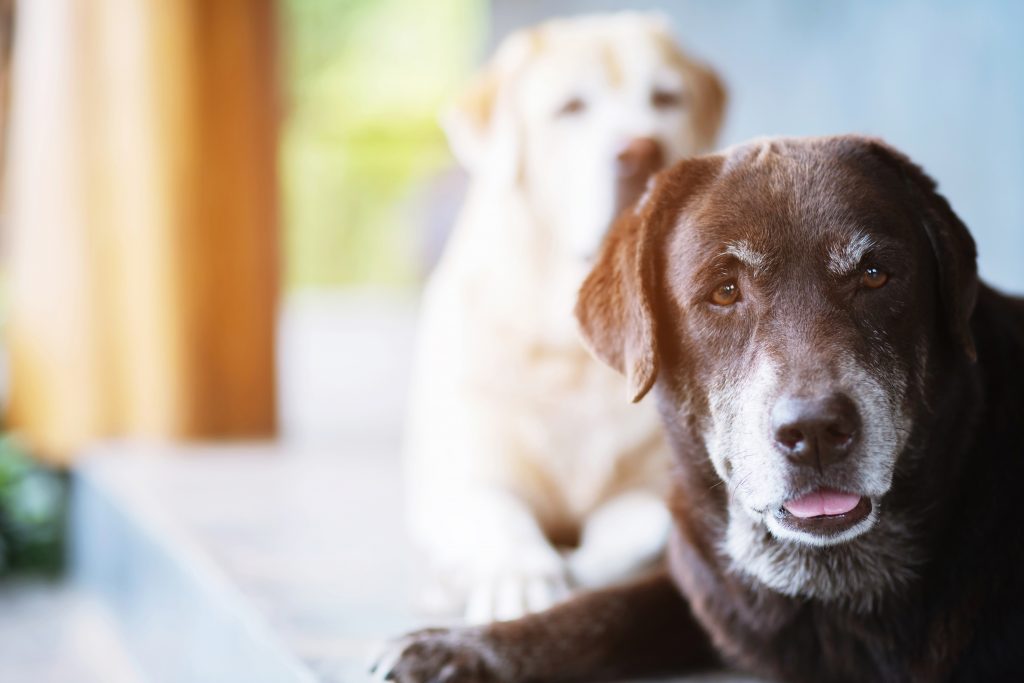Watching your furry friend get old can be challenging. Often when your dog progresses in years, it begins to experience aches and pains in its joints and muscles. These ailments can make it difficult for your senior dog to stay mobile and get around.
Symptoms your dog may be struggling with joint pain
As your dog gets older, it is necessary to watch out for joint pain symptoms. Symptoms include:
- Sitting, standing, or lying down is difficult for your dog
- Your dog takes a long time to stand up
- Swelling or stiffness of the joints
- It has a hard time going up or down the stairs
- Your dog no longer wants to run around or jump
- Its activity levels are lower than usual
- Your dog is limping or raising its leg off the ground
Tips you can try to ease your dog’s joint pain
Now that you know the symptoms to look out for, we have compiled a list of top tips you can try to help your senior dog maintain mobility, cope with pain and feel comfortable.
Tip One: Consult your vet about helpful treatments
Anti-inflammatory medication can assist with the joint pain your senior dog is experiencing. Another option is chondroprotective agents, which can help your dog’s body repair cartilage and encourage function. You can discuss the different treatment options with your vet to find the right one for your furry friend.
Tip Two: Make sure your dog is eating a nutritious diet and is at a healthy weight
Extra weight can put a burden on your dog’s joints. So make sure that you are feeding your dog a nutritious diet full of vitamins, like omega- 3 fatty acids, glucosamine, and chondroitin sulphate. A well-balanced diet will help your dog maintain a healthy weight and relieve joint pain.
Tip Three: Give your dog a joint-support supplement
Joint-support supplements provide your furry friend with the vitamins it needs to age gracefully. We suggest giving your dog the Zesty Paws Senior Advanced Glucosamine for Dogs, which helps to reduce discomfort, improve mobility, cushion joints, and keep your dog active.
Please remember to consult your vet before you give your dog a new supplement.
Tip Four: Take your dog on gentle daily walks
Gentle exercise like a daily walk will be beneficial for your senior dog. It will assist in strengthening its muscles and ligaments to prevent injuries. A walk outside also stimulates your furry friend’s mind and will help them experience a better quality of life.
Remember not to over-exercise your dog. Your dog loves you and will try and keep up with your activity level, so don’t take your dog on long hikes or runs if it is experiencing sore joints.
Tip Five: Make sure your dog has a soft and comfy bed
When your dog is experiencing joint pain, a comfortable bed will provide relief. Your dog’s bed needs to be well-cushioned and low to the ground. If you have extra money, we suggest going for an orthopaedic or memory foam dog bed specifically designed to provide comfort for dogs struggling with joint pain.
Tip Six: Provide your dog with extra traction
Your senior dog struggles to walk at the best of times when it experiences joint and muscle pain. Hardwood floors, tiles, and stairs can be complicated for your dog to navigate because they can be extra slippery. Put non-skid runners and mats down because they make it is easier for your dog to maintain traction on the floor. You can also put ramps and cubes next to stairs and couches to make it easy for your dog to climb onto.
Tip Seven: Clip your dog’s nails
Long nails can impact the way your dog walks and change the way the joints and muscles function, causing them additional pain. Clip your senior dog’s nails regularly to prevent this from happening.
Tip Eight: Massage your dog’s sore joints and muscles
Gently massaging your furry friend’s stiff muscles can relieve pain, improve circulation, and boost mobility and flexibility. It will also help your dog relax. Don’t put direct pressure on your dog’s joints as this will cause pain.
If you’re afraid of hurting your dog, take them to a professional dog massage therapist. Alternatively, take your dog for doggy acupuncture, which will increase blood flow in the muscles and help with pain management.
Tip Nine: Use a pet heating pad
Like massage, a warm heating pad can help relieve the pain on your dog’s joints. Be careful when choosing the right heating pad for your dog. Human heating pads can burn its skin. We suggest using a small microwaveable heating pad, designed for pets.
Tip 10: Put your dog’s food and water in an easy-to-reach spot
To prevent dehydration and malnutrition, make it easy for your dog to get its food and water by putting it low enough and near enough for them to reach, even when it is experiencing severe pain.
Medical therapy that may help with your dog’s joint pain
All of the above tips should help to relieve your faithful, furry friend’s pain. However, you may want to try additional medical treatments or therapy to help your dog. We suggest you consult your vet about the following options:
- PEMF Therapy
- Vitamin B-12 Injections
- Laser Therapy
- Doggy Physio
- Warm Water Hydrotherapy
Conclusion
Your furry friend means the world to you. So give these tips a try to help your senior dog experience joint pain relief.
If you are interested in ordering joint-support supplements for your dog, you can order online.
Sources
https://www.preventivevet.com/dogs/how-to-help-an-older-dog-with-arthritis-and-other-mobility-issues
https://pets.webmd.com/dogs/features/treat-dog-pain-lameness#1
https://www.advantagepetcare.com.au/au/health/six-ways-treat-arthritis-your-dog/
